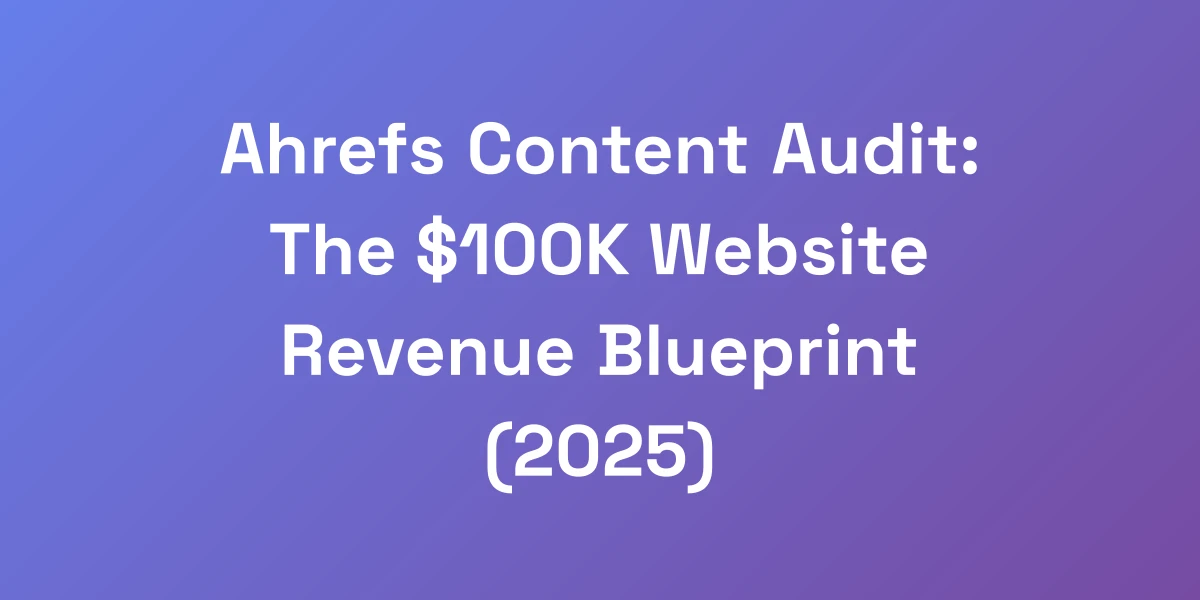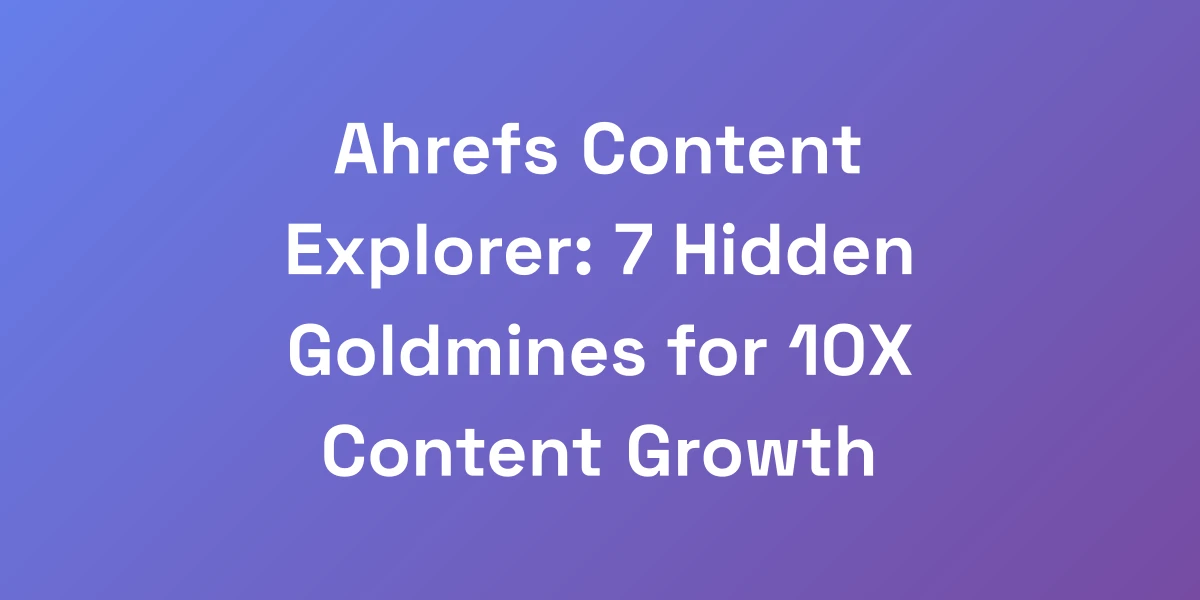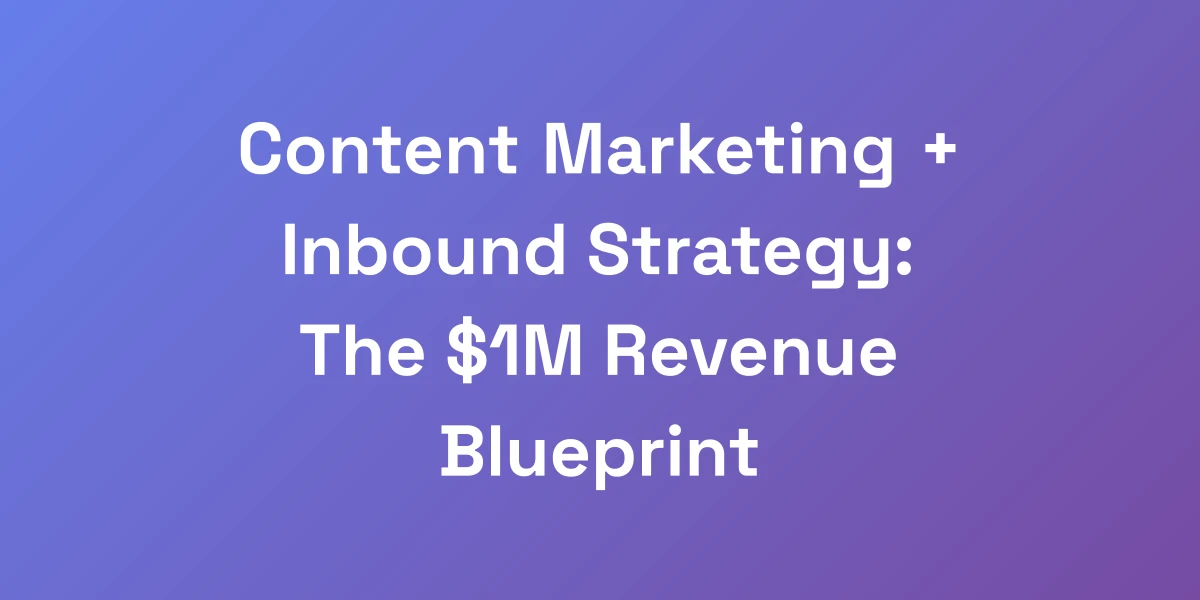
Ahrefs Content Gap Analysis: 5-Step Blueprint to Crush Competitors
Mar 31, 2025 | By [email protected]
Understanding Content Gap Analysis: The $100K Revenue Opportunity
Let us cut through the BS right now – content gap analysis isn’t just another SEO buzzword. It’s literally free money sitting on the table that your competitors are snatching up while you’re sleeping.
We’ve seen firsthand how Ahrefs’ content gap tool can uncover keyword opportunities worth over $100K in potential revenue for our clients. Here’s the truth: if you’re not systematically analyzing what keywords your competitors rank for that you don’t, you’re leaving serious money on the table.
But fear not. We’re here to fix that today with a no-fluff, actionable blueprint that will have you dominating your niche in no time. Ready to crush your competitors? Let’s dive into the core of content gap analysis and unlock the strategies that can transform your SEO game.
Why Traditional Keyword Research Is Dying
Traditional keyword research is like fishing with a sieve – you’re filtering out the big opportunities while letting the small ones slip through. It focuses too much on generic keywords and not enough on the nuanced phrases your audience is actually searching for.
Consider this: you might be targeting high-volume keywords that everyone else is chasing, but missing out on long-tail keywords that cater directly to your audience’s specific needs. These long-tail keywords often convert better because they match the user intent more precisely. Embracing search engine optimization automation can help you identify these valuable long-tail opportunities efficiently.
Moreover, traditional methods often ignore the competitive landscape. You’re not just finding keywords; you’re finding the right keywords that your competitors are exploiting to drive traffic and revenue. Content gap analysis as an SEO strategy is essential to identify these strategic opportunities.
The Real Power of Competitive Content Analysis
Competitive content analysis is where the real magic happens. By understanding what your competitors are doing, you can identify gaps in your own strategy and capitalize on opportunities they’ve overlooked.
Imagine knowing exactly which keywords are driving traffic to your competitors’ sites but haven’t been tapped into by yours. That knowledge isn’t just power; it’s a pathway to significant revenue growth. With Ahrefs’ content gap tool, and by integrating AI-powered SEO automation, you can pinpoint these opportunities with surgical precision.
This goes beyond just keyword identification. It’s about understanding the content structure, the topics covered, and the depth of information your competitors are providing. This comprehensive insight allows you to create content that not only matches but surpasses the competition.
How Top Brands Use Content Gaps to Scale Revenue
Top brands aren’t just lucky; they’re strategic. They leverage content gap analysis to continuously refine and expand their content strategies, ensuring they stay ahead in the SEO game.
Take Beehiiv, for example. By conducting a thorough content gap analysis, they identified under-covered topics that resonated with their audience. The result? A 69% increase in new visitors by simply addressing specific needs that were previously overlooked.
Similarly, HubSpot utilized content refreshment strategies derived from gap analysis. They updated existing content to better align with current search intent, leading to increased traffic and conversions while drastically reducing content production costs by over 80%.
These examples underscore the importance of not just identifying gaps but acting on them swiftly and effectively. It’s about creating a continuous feedback loop where your content strategy evolves in response to both your audience’s needs and the competitive landscape.
Common Content Gap Analysis Mistakes to Avoid
But it’s not all smooth sailing. Many businesses stumble when attempting content gap analysis. Here are some common mistakes to watch out for:
- Overlooking Competitor Long-tail Keywords: Long-tail keywords might have lower search volumes, but they often have higher conversion rates. Ignoring them can mean missing out on valuable traffic.
- Focusing Solely on High-Volume Keywords: Chasing high-volume keywords can lead to fierce competition and lower chances of ranking. Balancing between high-volume and strategic long-tail keywords is crucial.
- Lack of Regular Audits: SEO isn’t a set-and-forget game. Content gap analysis methods help you stay updated with the latest trends and adjust your strategy accordingly.
- Neglecting User Intent: Understanding the why behind a search query is essential. Content that doesn’t align with user intent will fail to engage and convert.
Avoiding these pitfalls ensures that your content gap analysis is both effective and efficient, paving the way for sustained SEO success.
Setting Up Your Content Gap Strategy for Success
Now that we’re aware of the common mistakes, let’s set up your content gap strategy for absolute success. It’s about creating a robust framework that you can rely on consistently.
Start by clearly defining your goals. Are you aiming to increase traffic, boost conversions, or enhance brand authority? Your objectives will guide the entire analysis process.
Next, identify your primary and secondary competitors. These are not always the biggest names in your industry but those who genuinely share your target audience and keywords.
Finally, establish a routine for your analysis. Content gap intelligence shouldn’t be a one-time task; it needs to be an ongoing process to adapt to evolving market conditions and search engine algorithms. Additionally, adopting SEO strategies tailored for startups can provide nuanced approaches that help you stay agile in competitive environments.
With these foundational steps, you’re ready to dive deeper into leveraging Ahrefs for maximum content gap intelligence.
Setting Up Ahrefs for Maximum Content Gap Intelligence
Listen, we’ve spent thousands of hours testing every SEO tool out there, and nothing comes close to Ahrefs for content gap analysis. But here’s what nobody tells you – 90% of users are setting it up wrong. They’re missing the crucial filters and settings that separate gold-mine keywords from time-wasting rabbit holes.
We’re here to change that. We’re going to show you exactly how to configure Ahrefs to find keywords that actually convert into revenue, not just vanity metrics.
Essential Ahrefs Account Configuration Steps
First things first, you need to ensure your Ahrefs account is configured correctly. Here’s how:
- Set Up Your Project: Start by adding your website and your competitors’ websites to the Ahrefs dashboard. This will form the foundation of your content gap analysis.
- API Integration: Integrate your Ahrefs account with other tools you use, like Google Analytics and Search Console, for a holistic view of your SEO performance.
- User Permissions: Ensure that your team members have the appropriate access levels to collaborate effectively without compromising sensitive data.
These steps ensure that your data is centralized and easily accessible, making your content gap analysis more efficient and comprehensive.
Identifying Your True Competition (Not Who You Think)
Next up, identifying your true competition is crucial. It’s not always the biggest players in your industry, but those who share your keyword landscape and target audience. Here’s how to pinpoint them:
- Keyword Overlap: Use Ahrefs to see which sites are ranking for the same keywords as you. These are your real competitors.
- Traffic Sources: Analyze where your competitors are getting their traffic from. It’s not just about organic search; it’s also about referral traffic, social media, and more.
- Niche Relevance: Ensure that the competitors you’re analyzing are directly relevant to your niche. Irrelevant competitors can skew your analysis and lead to misguided strategies.
By focusing on the right competitors, you can identify the most lucrative content gaps and tailor your strategy accordingly.
Setting Up Custom Filters for High-Value Keywords
Not all keywords are created equal. To maximize your content gap analysis, you need to set up custom filters in Ahrefs to identify high-value keywords:
- Search Volume Threshold: Set a minimum search volume to ensure you’re targeting keywords with sufficient traffic potential.
- Keyword Difficulty: Focus on keywords with a reasonable difficulty score where you have a realistic chance of ranking.
- Commercial Intent: Include filters for keywords that indicate strong commercial intent, ensuring they align with your revenue goals.
These custom filters will help you sift through the noise and concentrate on keywords that can drive meaningful traffic and conversions.
Traffic Potential vs. Keyword Difficulty Analysis
Balancing traffic potential with keyword difficulty is essential for a successful content gap strategy. Here’s how to do it:
- Assess Traffic Potential: Evaluate the monthly search volume and the potential traffic each keyword can bring.
- Evaluate Difficulty: Analyze the keyword difficulty score provided by Ahrefs to determine how challenging it will be to rank.
- Opportunity Score: Develop an opportunity score by combining traffic potential and difficulty. Focus on keywords with high potential and manageable difficulty.
This balanced approach ensures that you’re targeting keywords that can bring in significant traffic without requiring disproportionate effort to rank.
Creating Custom Reports for Actionable Insights
Finally, create custom reports in Ahrefs to turn your data into actionable insights. Here’s how:
- Identify Key Metrics: Focus on metrics like search volume, keyword difficulty, and traffic potential.
- Visualize Data: Use charts and graphs to make your data more understandable and highlight key opportunities.
- Regular Updates: Schedule regular reports to keep track of your progress and adjust your strategy as needed.
Custom reports provide a clear roadmap of your content gap analysis, helping you make informed decisions and prioritize your SEO efforts effectively.
The 5-Step Content Gap Analysis Process That Actually Works
Most people overcomplicate content gap analysis. They get lost in endless data and never take action. Here’s the brutal truth: you need a systematic process that you can execute consistently.
We’ve refined this process across hundreds of websites, and it consistently delivers results. It’s the same framework we used to help a client go from zero to 100K monthly organic visitors in just 8 months. Let us show you exactly how to do it.
Step 1: Competitive Landscape Mapping
Start by mapping out your competitive landscape. Identify who your true competitors are and what keywords they’re ranking for that you’re not.
- List Competitors: Use Ahrefs to list out your top 5-10 competitors based on keyword overlap and traffic sources.
- Analyze Their Content: Examine the type of content they’re producing – blog posts, videos, guides – and the topics they cover.
- Identify Shared Keywords: Look for keywords that multiple competitors are ranking for but you’re missing.
This step sets the foundation for identifying where you stand and what gaps you need to fill to outperform your competition.
Step 2: High-Impact Keyword Identification
Once you’ve mapped out the competitive landscape, it’s time to identify high-impact keywords that can drive significant traffic and conversions.
- Focus on Relevance: Ensure the keywords align with your business objectives and audience’s needs.
- Evaluate Search Volume: Prioritize keywords with substantial search volumes that can bring in meaningful traffic.
- Assess Commercial Intent: Select keywords that indicate a high likelihood of conversion, such as those related to purchasing decisions or specific services.
By targeting high-impact keywords, you ensure that your efforts are focused on opportunities that can generate real business value.
Step 3: Content Opportunity Scoring
Not all content opportunities are created equal. Content opportunity scoring helps you prioritize which gaps to fill first based on their potential impact.
- Assign Scores: Develop a scoring system based on factors like search volume, keyword difficulty, and relevance to your business.
- Rank Opportunities: Rank each keyword opportunity based on its score to identify the most valuable targets.
- Focus on Top Opportunities: Start with the highest-scoring opportunities that offer the best balance of traffic potential and achievability.
Content opportunity scoring ensures that you’re investing your resources in the most promising areas, maximizing your ROI.
Step 4: Quick-Win vs. Long-Term Planning
Effective content gap analysis distinguishes between quick wins and long-term strategies. Both are essential, but they require different approaches.
- Quick Wins: Identify low-hanging fruit – keywords with moderate difficulty and good search volume that you can rank for quickly.
- Long-Term Planning: Target high-difficulty keywords that may take more time and resources to rank for but offer substantial traffic and revenue potential.
- Balance Your Efforts: Allocate resources to both quick wins and long-term projects to ensure steady growth and sustained success.
This balanced approach allows you to maintain momentum while building a strong foundation for future growth.
Step 5: Implementation Priority Matrix
The final step is creating an implementation priority matrix to organize and execute your content gap strategy effectively.
- Define Priorities: Use the matrix to prioritize content creation based on factors like opportunity score, resource availability, and strategic importance.
- Set Timelines: Assign realistic timelines for each content piece to ensure steady progress without overwhelming your team.
- Monitor Progress: Regularly review your matrix to adjust priorities based on performance and any new opportunities that arise.
With an implementation priority matrix, you can stay organized, focused, and efficient in executing your content gap analysis strategies.
Advanced Content Gap Tactics for Rapid Growth
Once you’ve mastered the basics, it’s time to implement the advanced strategies that separate six-figure websites from the rest. These aren’t your typical “create better content” tips. We’re talking about specific, tactical moves that leverage Ahrefs’ content gap tool in ways your competitors haven’t figured out yet.
These are the exact methods we use to help clients dominate their markets, and we’re laying them all out for you.
Leveraging Featured Snippet Opportunities
Featured snippets can catapult your content to the top of search results, driving immense traffic. Here’s how to target them:
- Identify Snippet-Friendly Keywords: Use Ahrefs to find keywords that trigger featured snippets and have a higher chance of being selected by Google.
- Create Structured Content: Format your content with clear headings, bullet points, and concise answers to common questions related to the keyword.
- Optimize for Voice Search: With the rise of voice assistants, structuring your content to answer questions directly increases the likelihood of being featured.
By targeting featured snippets, you can significantly boost your visibility and authority in search results.
Content Cluster Gap Analysis
Content clustering involves organizing your content around central themes to improve SEO and user engagement. Here’s how to analyze and build effective content clusters:
- Identify Core Topics: Use Ahrefs to find the main topics that are relevant to your business and have significant search volume.
- Find Supporting Keywords: Identify related keywords that support your core topics, filling in gaps that your competitors might have overlooked.
- Create Linked Content: Develop content pieces that interlink around your core topics, creating a robust internal linking structure that boosts SEO authority.
Content clusters not only improve your SEO rankings but also provide a better user experience by organizing information logically and comprehensively. For business blogging strategies, learn more from Growth Natives’ guide to content gap analysis.
Competitor Content Quality Scoring
Understanding the quality of your competitors’ content helps you set benchmarks and strive for excellence. Here’s how to score and surpass their content:
- Evaluate Content Depth: Assess how thoroughly your competitors cover a topic. Aim to provide more comprehensive and detailed information in your content.
- Analyze Engagement Metrics: Look at metrics like time on page and bounce rate using Ahrefs and other analytics tools to gauge user engagement.
- Improve Readability and Structure: Ensure your content is well-organized, easy to read, and visually appealing with the use of headers, bullet points, and images.
By focusing on content quality, you can create superior content that not only ranks higher but also resonates more with your audience. Additional insights can be found at Eskritor’s content gap analysis.
International Content Gap Opportunities
Expanding your content strategy to international markets can open up new revenue streams. Here’s how to identify and leverage international content gaps:
- Local Keyword Research: Use Ahrefs to find keywords that are popular in specific regions but are not yet targeted by your content.
- Translate and Localize Content: Ensure your content is not just translated but also culturally adapted to resonate with the local audience.
- Optimize for Local Search Engines: Understand the search engine preferences and algorithms of different regions to optimize your content accordingly.
By targeting international content gaps, you can tap into new audiences and significantly scale your growth beyond local markets.
Local SEO Content Gap Strategies
For businesses targeting specific geographic areas, local SEO is crucial. Here’s how to capitalize on local content gaps:
- Geo-Specific Keywords: Identify keywords that include local terms and phrases your competitors might be missing.
- Localized Content: Create content that addresses local events, news, and specific needs of the community.
- Google My Business Optimization: Ensure your Google My Business profile is fully optimized with up-to-date information, reviews, and local keywords.
Effective local SEO strategies can help you dominate your local market, attracting customers who are ready to convert.
Turning Content Gap Insights into Revenue
Here’s what nobody in the SEO world wants to admit: ranking for new keywords means nothing if you can’t convert that traffic into revenue.
We’re going to show you how to prioritize content gaps based on actual business impact, not just search volume. This is the framework we use to help businesses turn content gap analysis into real ROI.
Stop chasing vanity metrics and start focusing on what actually moves the needle for your business.
Creating a Content ROI Framework
The first step in turning insights into revenue is creating a content ROI framework. Here’s how:
- Define Success Metrics: Identify what success looks like for your business – whether it’s leads, sales, or another conversion metric.
- Map Keywords to Business Goals: Align each targeted keyword with specific business objectives to ensure relevance and impact.
- Estimate Revenue Potential: Calculate the potential revenue each content gap could generate based on its traffic and conversion rate.
With a clear ROI framework, you can prioritize your content efforts based on financial impact, ensuring every piece of content contributes to your bottom line.
Conversion-Focused Content Planning
Creating content with conversions in mind is essential. Here’s how to plan effectively:
- Identify Conversion Triggers: Determine what prompts your audience to convert – be it specific information, persuasive calls-to-action, or compelling offers.
- Design Content for the Funnel: Create content tailored to different stages of the buyer’s journey, from awareness to decision-making.
- Use Persuasive Elements: Incorporate elements like testimonials, case studies, and clear CTAs to guide readers towards conversion.
By focusing on conversion at every step, you ensure that your content not only attracts traffic but also turns visitors into customers.
Content Gap A/B Testing Strategy
A/B testing is a powerful tool for optimizing your content gap strategies. Here’s how to implement it:
- Create Variations: Develop different versions of your content targeting the same keyword to see which performs better.
- Test Key Elements: Experiment with headlines, CTAs, images, and content structure to identify what resonates most with your audience.
- Analyze Results: Use analytics tools to assess the performance of each variation and implement the winning strategies across your content.
A/B testing helps you refine your content strategies based on actual user behavior, ensuring continuous improvement and higher conversion rates.
Measuring Content Gap Success
To ensure your content gap analysis is driving results, you need to measure its success accurately. Here’s how:
- Track Key Metrics: Monitor metrics like organic traffic, keyword rankings, and conversion rates to gauge performance.
- Use Dashboards: Create dashboards in Ahrefs and Google Analytics to visualize your progress and identify trends over time.
- Set Benchmarks: Establish benchmarks for each key metric to measure your progress and set targets for improvement.
Regularly measuring success allows you to adjust your strategies in real-time, ensuring your efforts are always aligned with your business goals. Additionally, SEO freelancing professionals can leverage these structured measurement techniques by offering clients detailed ROI analyses.
Scaling What Works (And Cutting What Doesn’t)
Effective scaling involves doubling down on what works and trimming the fat from what doesn’t. Here’s how to do it:
- Identify High-Performing Content: Use your success metrics to pinpoint the content pieces that are driving the most traffic and conversions.
- Allocate Resources: Invest more resources into creating similar high-performing content and expanding on successful topics.
- Eliminate Underperformers: Identify content that isn’t delivering results and either improve it or remove it to save resources.
By focusing on what works, you can scale your content strategy efficiently, maximizing your ROI and driving sustained growth.
Conclusion
We’ve walked you through the comprehensive blueprint for mastering content gap analysis using Ahrefs. From setting up your tools correctly to implementing advanced tactics and turning insights into revenue, you now have the roadmap to crush your competitors and unlock significant revenue opportunities.
Remember, content gap analysis isn’t a one-time task; it’s an ongoing strategy that, when executed effectively, can transform your SEO performance and drive substantial business growth.
Ready to take action? Start implementing these strategies today and watch your website climb the search rankings, attract more traffic, and convert visitors into loyal customers.
Got questions or want to share your success stories? Drop a comment below and let’s engage. Together, we can dominate the SEO game and achieve remarkable results.








